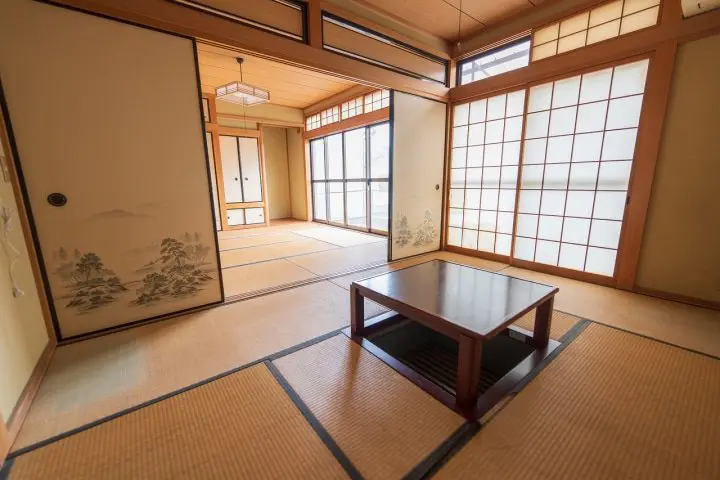Kotatsu and Horigotatsu: Japan's Table Heaters

The kotatsu and horigotatsu are table heaters used in Japanese homes. Learn about their features, how to use them, and where to experience these winter appliances in Japan.

Photo by Pixta
A kotatsu is a type of home heater. It consists of a low table placed over an electric heater and covered with a quilt or heavy blanket to trap in heat. You can warm your lower body by sitting at the table and relaxing under the blanket.
A sunken kotatsu (horigotatsu) is another heating table incorporated into a recessed floor. Sitting in a chair and dangling your feet into the warmth below is an experience unique to the sunken kotatsu.
Read on to lear more about kotatsu and where to experience them in Japan.
Kotatsu and Horigotatsu
1. The Origins of the Kotatsu
2. Lifestyle Changes and the Kotatsu
3. Exprience Kotatsu in Japan
1. The Origins of the Kotatsu
In the past, people warmed themselves by sitting in front of an irori, or open hearth in Japanese. (The irori refers to the square cut out of the floor where a fire is lit).
Unfortunately, this open hearth was not efficient in warming up the entire body. So around the end of the 14th century, they devised a wooden frame (called yagura) to place over the dying embers of the fire and put a quilt on top to keep the heat from escaping. This is thought to be the origin of the kotatsu.

Photo by Pixta
In the 17th century, the heater was made portable by placing hot charcoal in earthenware or ceramic containers. This portable heating device was known as an anka (a type of foot or bed warmer) and is the predecessor of the modern kotatsu.
In the 1950s, the kotatsu switched its heat source from charcoal and briquettes to electricity. The electric kotatsu quickly became a popular appliance in Japanese households.

↑ Return to the top of article.
2. Lifestyle Changes and the Kotatsu
Until the 1980s, it was customary for every household to have an electric kotatsu. The image of people sitting under the kotatsu and eating mandarin oranges has become a classic winter scene. Although Western lifestyles have become widely incorporated in Japan, it remains commonplace for households to use this low, wooden table with an electric heater underneath. Some even use the kotatsu outside of the winter months, treating it like a fashionable piece of furniture.
In recent years, households without a kotatsu have increased with the arrival of numerous heating devices. However, Japanese-style restaurants and izakayas (Japanese-style pubs) often have seats surrounding a sunken kotatsu, allowing guests to enjoy a traditional kotatsu experience.
↑ Return to the top of article.
3. Experience Kotatsu in Japan
While the number of households with a kotatsu is decreasing in Japan, there are many restaurants and cafes that offer tables with a sunken horigotatsu, not only because it is practical, but also to respond to the needs of customers who feel nostalgic about kotatsu heaters.

An example of such a cafe is Cafe Stay Happy in Tokyo's Shimokitazawa district. Born from the owner's passion for travel, Cafe Stay Happy offers a cozy decor with a kotatsu service in winter, providing customers the chance to enjoy the comfort of traditional Japanese table heaters.
Another great place to experience a kotatsu is Ikinasakana Jizake Zagin, a Japanese-style pub located just 3 minutes away from Kanazawa Station.
Here you can enjoy in delicious sake accompanied by seasonal dishes, including exquisite crab cuisine in winter.
If you're traveling to Japan in winter, we hope you'll take the chance to experience the pleasant warmth of kotatsu heaters.
Areas with traditional houses such as Hida-Takayama or places with cold winters such as Kanazawa, Niigata, and areas in Tohoku is where you'll definitely find dining facilities with kotatsu heaters. Offering heated seating is a core priority for facilities in the hospitality industry in these regions.
ライター兼翻訳者、時にマーケティング調査員の顔も。訪日旅行客向けに東京都内レストランメニューの翻訳データ・ベースの作成や、宿・ホテル情報検索サイトの翻訳も手掛けてきました。旅行と食材研究が趣味です。






































![[Yufuin] From breathtaking views to skin-beautifying hot springs. A variety of day trip hot springs to fully enjoy Yufuin](https://resources.matcha-jp.com/resize/720x2000/2026/01/18-255919.webp)

![[2026] The Matsusaka Lantern Festival will be held to light up the winter night sky!](https://resources.matcha-jp.com/resize/720x2000/2026/01/05-254777.webp)
![[List of Traditional Industry Experiences] Factory tours and craftsmanship experiences in southern Osaka and Wakayama](https://resources.matcha-jp.com/resize/720x2000/2025/11/06-249221.webp)
